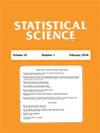随机试验中的意向治疗比较
IF 3.9
1区 数学
Q1 STATISTICS & PROBABILITY
引用次数: 4
摘要
意向治疗(ITT)比较在随机对照试验的报告中具有核心地位,尽管通常还有其他感兴趣的分析,例如对不依从性进行调整的分析。在我们对妇女健康倡议(WHI)随机试验结果的ITT报告中,我们主要依赖于高度灵活的风险比(Cox)回归方法。然而,这些方法,特别是比例危险特例,被批评为难以解释,经常过于简单化,并且与使用潜在结果的现代因果关系理论不一致。在这里,我们讨论了这些主题,并扩展了我们在WHI试验中使用ITT比较的危险率方法。本文章由计算机程序翻译,如有差异,请以英文原文为准。
Intention-to-Treat Comparisons in Randomized Trials
Intention-to-treat (ITT) comparisons have a central place in reporting on randomized controlled trials, though there are typically additional analyses of interest such as those making adjustments for nonadherence. In our ITT reporting of results from the Women’s Health Initiative (WHI) randomized trials we have relied primarily on highly flexible hazard ratio (Cox) regression methods. However, these methods, especially the proportional hazards special case, have been criticized for being difficult to interpret and frequently oversimplified, and for not being consistent with modern causality theories using potential outcomes. Here we address these topics and extend our use of hazard rate methods for ITT comparisons in the WHI trials.
求助全文
通过发布文献求助,成功后即可免费获取论文全文。
去求助
来源期刊

Statistical Science
数学-统计学与概率论
CiteScore
6.50
自引率
1.80%
发文量
40
审稿时长
>12 weeks
期刊介绍:
The central purpose of Statistical Science is to convey the richness, breadth and unity of the field by presenting the full range of contemporary statistical thought at a moderate technical level, accessible to the wide community of practitioners, researchers and students of statistics and probability.
 求助内容:
求助内容: 应助结果提醒方式:
应助结果提醒方式:


